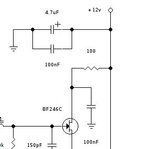neazoi
Advanced Member level 6
Hi, I have an oscillator and I would like to know if the way I did the rf filtering (with the bypass capacitors and the tantalum electrolytic), is effective enough. I consider 1-30MHz as the operation of the oscillator, are the values of the capacitors ok?

